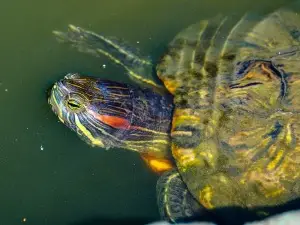
Turtles are cold-blooded, as all reptiles are, they need to bask in the sun to get warm and they need to bask quite regularly.
But, you may start to notice off things happening with your turtle as it basks, odd things like the animal twitching.
This article looks into why your turtle is twitching while basking
Table of Contents
Why does my turtle twitch while basking?
Twitching is actually not new to turtles, these animals may twitch their heads legs, heads, or their entire body depending on the circumstances.
Here are possible reasons why your turtle may be twitching:
Irritation on the skin:
One reason why your pet may be twitching while basking may be because the animal feels itchy and is using the twitching to try and relieve the itchy feeling.
Itching can happen if your pet’s skin starts to shed or if it becomes infected with parasites
The itchiness, as a result of parasites or skin shedding, will cause the animal’s skin to become very uncomfortable and this will prompt the animal to make these uncomfortable twitching movements while basking
What to do:
If you already know that your pet’s skin is shedding then you don’t have to worry, itchiness is quite normal for shedding turtles. This itching will be more pronounced once the animal basks and its skin gets drier
If your pet is shedding then allow the skin to shed off on its own naturally, avoid trying to peel the skin off yourself as this can be very distressful and painful to your turtle
You can examine your pet to see if it has any abrasions, cuts, or foreign objects that may be causing the itching
Also, check to see if there are any parasites on your pet’s body.
Metabolic bone disease:
Another reason why your pet turtle may be twitching may be because the animal has a condition called metabolic bone disease.
This disease may be common in tortoises but it is quite a severe and serious condition.
This condition can develop because of improper husbandry like insufficient UV lighting, feeding a diet too high in fat, feeding a diet too high in phosphorus, or a diet that is too low in calcium or vitamin D3.
Other signs of this condition in your pet, include skeletal deformities like softened facial bones, swelling or malformations of the shell and skeleton, lethargy, a loss of appetite, shaking, tremors, weakness, seizure, paralysis, and even death.
What to do:
This is quite a serious condition and is something that needs to be treated at the vet. The vet will examine the animal, take bloodwork, and do x-rays to diagnose the problem.
If you can’t immediately take your pet to a vet then isolating the animal will be a good idea, doing this will keep it from infecting other turtles in the enclosure and will keep it from having to compete for food in its weakened state.
Once the reptile is diagnosed the treatment will either be correcting any husbandry issues through an improved diet, changing the temperature in the enclosure, or the turtle getting daily UV exposure.
If you enjoyed this article then you may also be interested in other turtle/tortoise related articles. Here are some articles that you may be interested in: Turtle Kicking Legs While Basking, Red-Eared Slider Scratching Head, Why Is My Turtle Rubbing His Head, Why Is My Turtle Rubbing His Eyes, Why Is My Turtle Spazzing?, Why Is My Tortoise Twitching?, Why Is One Turtle Bigger Than The Other?, Why Is My Turtle Jumping, Tortoise Head Twitching


